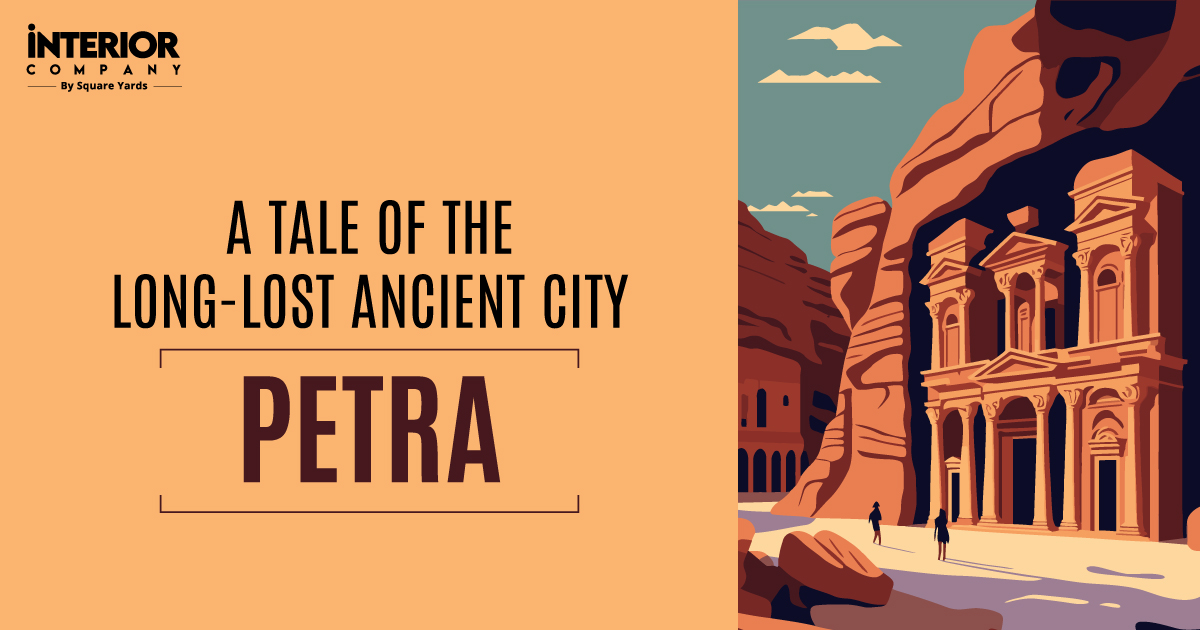- Kitchens
- Design Ideas
- Cities
- Trends
- Guides
- Price Calculators
- Our PortfolioNEW
- More
- Home
- Trends
- Architecture
- Buildings
- Taj Mahal Architecture
Taj Mahal Architecture: A Timeless Wonder Etched in Marble
“Goodbyes are only for those who love with their eyes. Because for those who love with heart and soul, there is no such thing as separation.” When Rumi composed these lines, he must have known how selfish yet how otherworldly love can be! It’s for this fleeting yet concrete feeling of love that had the greatest of emperors of the world aspire to be, bit dust, shed blood, dreamt timeless dreams, conquered vast stretches of land, and ultimately built eternal structures like the Taj Mahal- an undying echo of love lasting till kingdom come- all this, for love!
Table of Content
In its almost four centuries of existence, the Taj Mahal, an epitome of love, has been the focus of attention and inspiration for many poets, writers, and artists. All of them have viewed this symbol of love from their own creative lens and have subsequently weaved and passed their viewpoints and creative works down to the world.
Needless to say, the Taj Mahal's architecture is amongst the most beautiful in the world. Built as a memorial for his third wife, Begum Mumtaz Mahal, it has been etched down in history as a pillar of love. Legend has it that the death of his wife left Emperor Shah Jahan in a state of despair and grief, so much so that his hair turned grey overnight. The Taj Mahal architecture began the next year.
Also Read: Golden Temple Architecture
Architectural Features of the Taj Mahal
The architectural features of Taj Mahal are simply astounding to look at. Here are the Taj Mahal's structure details.
Perfect Symmetry
A sparkling jewel of Muslim architecture, the Taj Mahal boasts of perfectly beautiful looking symmetry which only adds to its overall charm. The main dome and the surrounding minarets are a delight to watch. The gardens are also divided into four canals. Their intersection at the raised central lotus pond is simply breathtaking to witness.
Built With an Optical Illusion
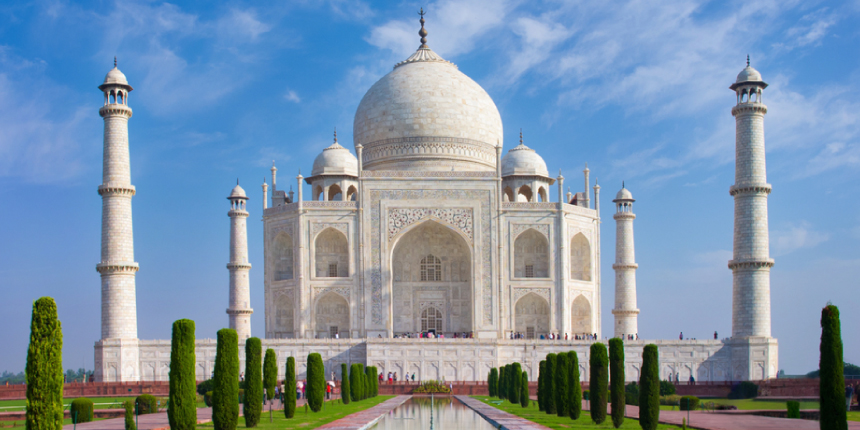
Many don't know but the Taj Mahal's all four minarets are placed in a specific way for creating a specific optical illusion – as soon as you enter the gates of the structure, the monument appears to be large in size, however, as you inch forward to explore, it appears to shrink in its size. A brilliant architectural feature indeed.
Built Using White Marble Throughout

Before the Taj Mahal, every Mughal structure was built using red sandstone. However, it is believed that Shah Jahan, an intellectual and a much revered Emperor of his times, had a liking towards the Hindu way of building structures. Thus, he wanted to try something different and took the liberty of using the white stone reserved only for Brahmins and gave instructions to his chief architects to use the same.
The Magnificent Walls of the Taj Mahal
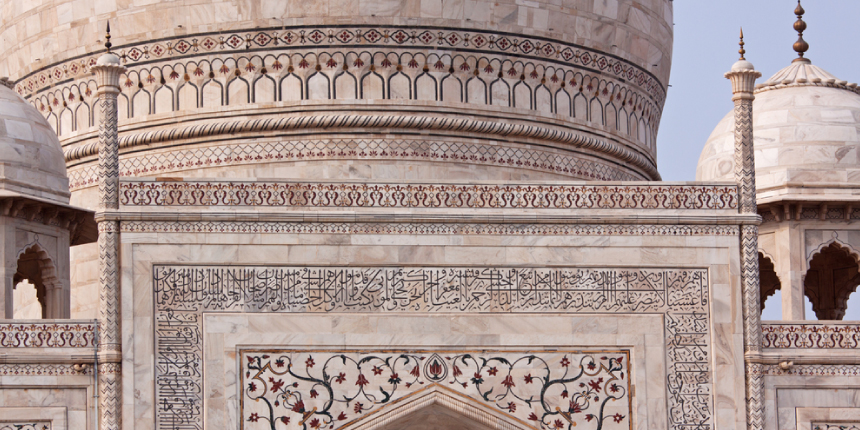
For adding a spiritual layer to the structure, it was decided to cover the entire monument with beautiful-looking calligraphy and Pietra Dura. For the unversed, Pietra Dura, a magnificent architectural feature of Taj Mahal is a method of inlaying marble with highly precious stones like amber, coral, and jade, as well as lapis lazuli. And to make the structure balmy on the eye, and to add to its architectural marvel, the Taj Mahal was decorated with abstract art along with vegetative motifs, mosaic art as well as incised painting.
Also Read: Udaipur City Place Architecture
Painting History: Four Minarets and One Central Dome of the Taj Mahal
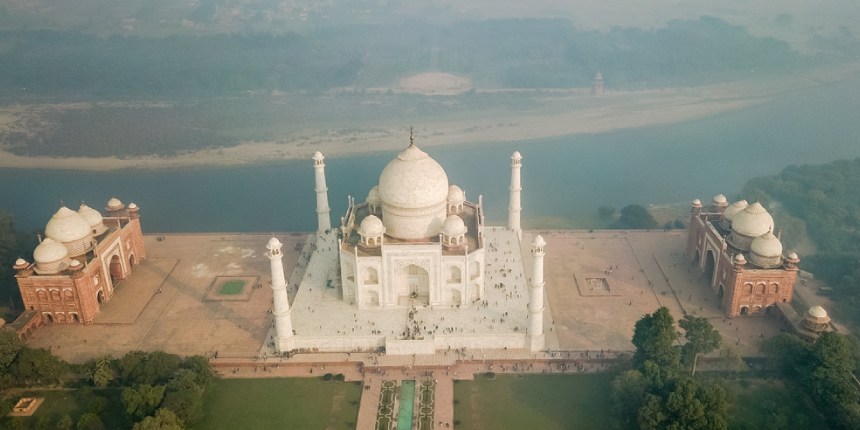
The placement of the minarets plays a significant role in the Islamic architecture. The Muslims call for prayer to be given from the top of these minarets. This essentially signifies seeking spiritual guidance from the almighty. Talking about the Taj Mahal, it is surrounded by four minarets. All of these slightly lean outwards from the main structure. This was a conscious measure to protect the tomb in case they happen to collapse during the course of a natural disaster, like an earthquake.
The dome of the Taj Mahal is a classic Persian dome. The structure consists of two main domes which include an outer dome built over an inner dome. The double technique has been consciously used to give the structure its required proportion. In a much more spiritual sense, the double dome structure signifies the heavensward progression of the soul.
The Visionary Architectural Style of the Taj Mahal
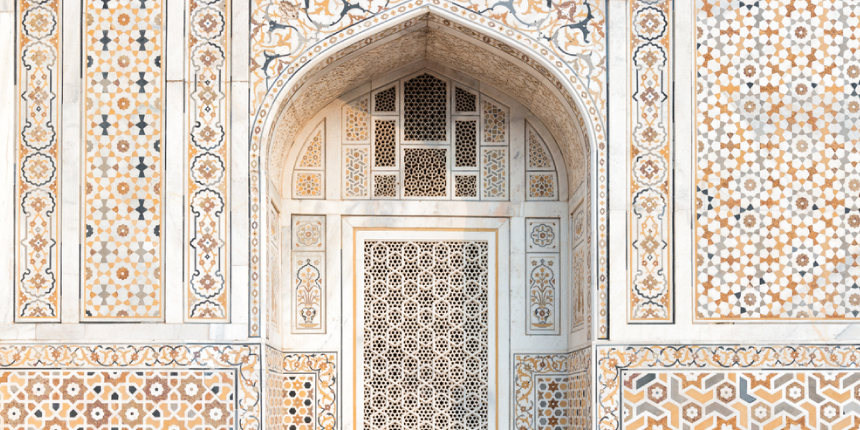
Lying at the intersection of Indian, Persian as well as Islamic architectural styles, the architectural brilliance with which the Taj Mahal was constructed is simply unparalleled. It took 22,000 workers, mavens of their craft, to complete a marvel of such stature.
Masons and artisans were called from across Asia and Iran. It was owing to this near perfect masonry that this remnant of Mughal architecture – the Taj Mahal – still holds its charm and legacy.
The Taj Mahal was built under the expert supervision of Ustad Ahmad, the chief architect of the Taj Mahal. All across the white marble of the Taj Mahal, there are marks of black calligraphy which is embossed in the Thuluth script and most of the etched verses have been borrowed from the Quran.
Architecture Facts
Here are some interesting facts about the Taj Mahal:
- The architectural design of Taj Mahal includes 28 types of semi-precious and precious stones. All of these gems were collected from countries like Sri Lanka, China, and Tibet.
- 1,000 elephants were used for the transportation of all the construction material.
- The Taj Mahal is approximately five feet taller than the Qutub Minar.
- More than 8 million people from across the world visit the Taj Mahal annually.
- Depending upon the light, the Taj Mahal reflects a range of colours. For instance, in the morning, it looks pinkish and during day time, it appears to be milky white. By dawn, it reflects a little golden colour.
- Many wouldn't know but the Taj Mahal has a mosque present in its complex. This is the reason why it is closed on Fridays.
In a Nutshell
Built in memory of Mumtaz Mahal – Shah Jahan's third wife who died while giving birth to their 14th child – the Taj Mahal is a rare gem of architecture. It is one of the last standing memories of the Mughal era. The precision and craft with which the Taj Mahal has been built is a rarity and remains unmatched. If you wish to enjoy everything that the Taj Mahal stands for then a visit here is a must.
Ready for a home transformation?
Let our designers assist you!
Recent Posts
Taj Mahal was built under the supervision of Ustad Ahmad who was the chief architect of the Taj Mahal.
The Taj Mahal’s construction started in 1632 and was completed in 1648. It took 22,000 expert workers who were called from various parts of India and Iran.
The Taj Mahal is a mausoleum. It houses the tombs of Mumtaz Mahal along with the Mughal emperor Shah Jahan.
Related Category
- Bedroom
- Exterior Design
- Kitchen
- Living Room
- Paint and Color





